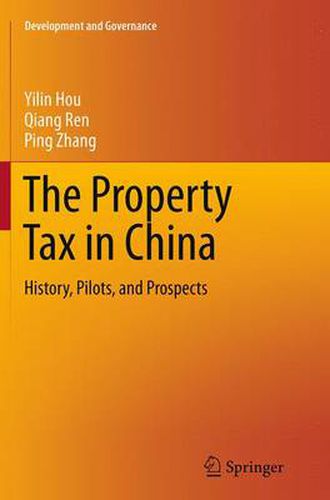Readings Newsletter
Become a Readings Member to make your shopping experience even easier.
Sign in or sign up for free!
You’re not far away from qualifying for FREE standard shipping within Australia
You’ve qualified for FREE standard shipping within Australia
The cart is loading…






This title is printed to order. This book may have been self-published. If so, we cannot guarantee the quality of the content. In the main most books will have gone through the editing process however some may not. We therefore suggest that you be aware of this before ordering this book. If in doubt check either the author or publisher’s details as we are unable to accept any returns unless they are faulty. Please contact us if you have any questions.
This monograph offers a detailed analysis of the creation, pilot implementation, and possible wide adoption of the real property tax at the local level in China. Starting in 2003, as China’s economy gradually recovered from the Asian financial crisis that started in 1998, the real property market entered a period of rapid expansion, followed immediately by rampant speculation, rising housing costs, and official corruption. Over the last ten years, the price of real property in most cities has more than tripled, especially in metropolitan areas. In an effort to curb this, the government has instituted a number of property-market controls, including property tax pilot programs in Shanghai and Chongqing. While this is the latest of a number of fiscal reforms, it is a very important one that carries with it the ability to change the landscape of public finance, intergovernmental relations, and local governance in China. It represents a fundamental change in the provision of public services, the relationship between local governments and tax payers, and the status of localities in the government structure. Taking a public choice perspective, the authors argue that the local property tax should be used not solely as a means of controlling housing prices but should be fully employed as a fiscal and budgetary institution that will contribute to mitigating multifarious socio-economic problems resulting from economic growth, rapid urbanization, and widening income disparity. As this program is the first of its kind, so this book is the first detailed study of property tax in China; as such, it will appeal to researchers of public finance and public policy. It will also be of great interest to policymakers in China and in other countries that are considering adopting or reforming their versions of the local property tax. It fills the gap in a growing body of literature about the inner workings of Chinese economics and policy.
$9.00 standard shipping within Australia
FREE standard shipping within Australia for orders over $100.00
Express & International shipping calculated at checkout
This title is printed to order. This book may have been self-published. If so, we cannot guarantee the quality of the content. In the main most books will have gone through the editing process however some may not. We therefore suggest that you be aware of this before ordering this book. If in doubt check either the author or publisher’s details as we are unable to accept any returns unless they are faulty. Please contact us if you have any questions.
This monograph offers a detailed analysis of the creation, pilot implementation, and possible wide adoption of the real property tax at the local level in China. Starting in 2003, as China’s economy gradually recovered from the Asian financial crisis that started in 1998, the real property market entered a period of rapid expansion, followed immediately by rampant speculation, rising housing costs, and official corruption. Over the last ten years, the price of real property in most cities has more than tripled, especially in metropolitan areas. In an effort to curb this, the government has instituted a number of property-market controls, including property tax pilot programs in Shanghai and Chongqing. While this is the latest of a number of fiscal reforms, it is a very important one that carries with it the ability to change the landscape of public finance, intergovernmental relations, and local governance in China. It represents a fundamental change in the provision of public services, the relationship between local governments and tax payers, and the status of localities in the government structure. Taking a public choice perspective, the authors argue that the local property tax should be used not solely as a means of controlling housing prices but should be fully employed as a fiscal and budgetary institution that will contribute to mitigating multifarious socio-economic problems resulting from economic growth, rapid urbanization, and widening income disparity. As this program is the first of its kind, so this book is the first detailed study of property tax in China; as such, it will appeal to researchers of public finance and public policy. It will also be of great interest to policymakers in China and in other countries that are considering adopting or reforming their versions of the local property tax. It fills the gap in a growing body of literature about the inner workings of Chinese economics and policy.